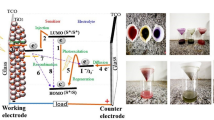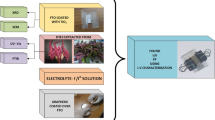Abstract
Carbon dots (CD) produced through chemical sources need a passivation agent, unlike those created from natural sources. These CD have a vivid luminescence, mainly in the blue spectrum, which can be used in various fields of science and engineering. In this study, we have utilized the widely available Allamanda cathartica flowers to produce CD through solvothermal process. The resulting CD exhibited excellent optical properties with a fluorescence lifetime of 4.71 ns and an average particle size of 3.23 nm. The CD were utilized as co-sensitizers in a dye-sensitized solar cell with N719 dye which showed four times more efficiency than the only CD-sensitized device.







Similar content being viewed by others
Data Availability
The datasets generated during and/or analysed during the current study are available from the corresponding author on reasonable request.
References
X. Xu, R. Ray, Y. Gu, H.J. Ploehn, L. Gearheart, K. Raker, and W.A. Scrivens, Electrophoretic analysis and purification of fluorescent single-walled carbon nanotube fragments. J. Am. Chem. Soc. 126(40), 12736 (2004).
K.S. Fernando, S. Sahu, Y. Liu, W.K. Lewis, E.A. Guliants, A. Jafariyan, P. Wang, C.E. Bunker, and Y.P. Sun, Carbon quantum dots and applications in photocatalytic energy conversion. ACS Appl. Mater. Interfaces 7(16), 8363 (2015).
D.S. Su and G. Centi, A perspective on carbon materials for future energy application. J. Energy Chem. 22(2), 151 (2013).
P. Tian, L. Tang, K.S. Teng, and S.P. Lau, Graphene quantum dots from chemistry to applications. Mater. Today Chem. 10, 221 (2018).
Y. Yan, J. Gong, J. Chen, Z. Zeng, W. Huang, K. Pu, J. Liu, and P. Chen, Recent advances on graphene quantum dots: from chemistry and physics to applications. Adv. Mater. 31(21), 1808283 (2019).
K. Surana and B. Bhattacharya, Fluorescence quenching by förster resonance energy transfer in carbon-cadmium sulfide core-shell quantum dots. ACS Omega 6(48), 32749 (2021).
P. Kalra, K. Surana, B. Bhattacharya, G. Singh, and G. Durga, Synergistic behaviour of silatrane functionalized perylene diimide dye and carbon quantum dots for enhancing photovoltaic performance. J. Mol. Struct. 1285, 135470 (2023).
Z. Kang and S.T. Lee, Carbon dots: advances in nanocarbon applications. Nanoscale 11(41), 19214 (2019).
X.T. Zheng, A. Ananthanarayanan, K.Q. Luo, and P. Chen, Glowing graphene quantum dots and carbon dots: properties, syntheses, and biological applications. Small 11(14), 1620 (2015).
Y.P. Sun, B. Zhou, Y. Lin, W. Wang, K.S. Fernando, P. Pathak, M.J. Meziani, B.A. Harruff, X. Wang, H. Wang, and P.G. Luo, Quantum-sized carbon dots for bright and colorful photoluminescence. J. Am. Chem. Soc. 128(24), 7756 (2006).
S. Li, L. Li, H. Tu, H. Zhang, D.S. Silvester, C.E. Banks, G. Zou, H. Hou, and X. Ji, The development of carbon dots: from the perspective of materials chemistry. Mater. Today 51, 188 (2021).
K. Surana, R.M. Mehra, S.S. Soni, and B. Bhattacharya, Real-time photovoltaic parameters assessment of carbon quantum dots showing strong blue emission. RSC Adv. 12(3), 1352 (2022).
S. Sagbas and N. Sahiner, Carbon dots: preparation, properties, and application, Nanocarbon and its Composites. (Woodhead Publishing, 2019), pp. 651–676.
M. Tuerhong, X. Yang, and Y.I.N. Xue-Bo, Review on carbon dots and their applications. Chinese J. Anal. Chem. 45(1), 139 (2017).
Y. Zhou, K.J. Mintz, S.K. Sharma, and R.M. Leblanc, Carbon dots: diverse preparation, application, and perspective in surface chemistry. Langmuir 35(28), 9115 (2019).
C. Long, Z. Jiang, J. Shangguan, T. Qing, P. Zhang, and B. Feng, Applications of carbon dots in environmental pollution control: a review. Chem. Eng. J. 406, 126848 (2021).
K.O. Boakye-Yiadom, S. Kesse, Y. Opoku-Damoah, M.S. Filli, M. Aquib, M.M.B. Joelle, M.A. Farooq, R. Mavlyanova, F. Raza, R. Bavi, and B. Wang, Carbon dots: applications in bioimaging and theranostics. Int. J. Pharm. 564, 308 (2019).
X. Zhang, M. Jiang, N. Niu, Z. Chen, S. Li, S. Liu, and J. Li, Natural-product-derived carbon dots: from natural products to functional materials. Chemsuschem 11(1), 11 (2018).
A.Y. Madkhli, G. Souadi, and S. Kakroo, Self-passivated carbon dots derived from Bougainvillea spectabilis for photovoltaic application. J. Mater. Sci. Mater. Electron. 34(10), 914 (2023).
V.L. Petricevich and R. Abarca-Vargas, Allamanda cathartica: a review of the phytochemistry, pharmacology, toxicology, and biotechnology. Molecules 24(7), 1238 (2019).
M. Narayan and A. Raturi, Investigation of some common Fijian flower dyes as photosensitizers for dye-sensitized solar cells. Appl. Sol. Energy 47, 112 (2011).
T. Raguram and K.S. Rajni, Characterization of TiO2 photoanodes and natural dyes (Allamanda Blanchetti and Allamanda Cathartica) extract as sensitizers for dye-sensitized solar cell applications. J. Sol-Gel Sci. Technol. 93, 202 (2020).
T.N. Tiwari, V.B. Pandey, and N.K. Dubey, Plumieride from allamanda cathartica as an antidermatophytic agent. Phytother. Res. 16(4), 393 (2002).
N.T.R.N. Kumara, P. Ekanayake, A. Lim, L.Y.C. Liew, M. Iskandar, L.C. Ming, and G.K.R. Senadeera, Layered co-sensitization for enhancement of conversion efficiency of natural dye sensitized solar cells. J. Alloys Compd. 581, 186 (2013).
K.S. Keremane, I.M. Abdellah, P. Naik, A. El-Shafei, and A.V. Adhikari, Simple thiophene-bridged D–π–A type chromophores for DSSCs: a comprehensive study of their sensitization and co-sensitization properties. Phys. Chem. Chem. Phys. 22(40), 23169 (2020).
L. Sang, L. Lei, J. Lin, and H. Ge, Co-sensitization of TiO2 electrode with Eosin Y dye and carbon dots for photoelectrochemical water splitting: the enhanced dye adsorption and the charge transfer route. Int. J. Hydrogen Energy 42(50), 29686 (2017).
X. Wang, L. Cao, F. Lu, M.J. Meziani, H. Li, G. Qi, B. Zhou, B.A. Harruff, F. Kermarrec, and Y.P. Sun, Photoinduced electron transfers with carbon dots. Chem. Commun. 25, 3774 (2009).
X. Dong, L. Wei, Y. Su, Z. Li, H. Geng, C. Yang, and Y. Zhang, Efficient long lifetime room temperature phosphorescence of carbon dots in a potash alum matrix. J. Mater. Chem. C 3(12), 2798 (2015).
W. Zhu, J. Duan, Y. Duan, Y. Zhao, and Q. Tang, Efficiency enhancement of hybridized solar cells through co-sensitization and fast charge extraction by up-converted polyethylene glycol modified carbon quantum dots. J. Power. Sources 367, 158 (2017).
J.C. Chou, R.H. Syu, P.H. Yang, P.Y. Kuo, Y.H. Nien, C.H. Lai, P.F. Chen, Y.T. Wu, and S.W. Zhuang, Graphene quantum dots as a co-sensitizer with improving light absorption for dye-sensitized solar cells. IEEE Trans. Nanotechnol. 22, 20 (2023).
W. Ghann, V. Sharma, H. Kang, F. Karim, B. Richards, S.M. Mobin, J. Uddin, M.M. Rahman, F. Hossain, H. Kabir, and N. Uddin, The synthesis and characterization of carbon dots and their application in dye sensitized solar cell. Int. J. Hydrogen Energy 44(29), 14580 (2019).
A. Bora, K. Mohan, and S.K. Dolui, Carbon dots as cosensitizers in dye-sensitized solar cells and fluorescence chemosensors for 2,4,6-trinitrophenol detection. Ind. Eng. Chem. Res. 58(51), 22771 (2019).
M.T. Efa and T. Imae, Effects of carbon dots on ZnO nanoparticle-based dyesensitized solar cells. Electrochim. Acta 303, 204 (2019).
H.F. Etefa, T. Imae, and M. Yanagida, Enhanced photosensitization by carbon dots co-adsorbing with dye on p-type semiconductor (nickel oxide) solar cells. ACS Appl. Mater. Interfaces 12(16), 18596 (2020).
H. Zou, D. Guo, B. He, J. Yu, and K. Fan, Enhanced photocurrent density of HTM-free perovskite solar cells by carbon quantum dots. Appl. Surf. Sci. 430, 625 (2018).
Funding
The authors declare that no funds, grants, or other support were received during the preparation of this manuscript.
Author information
Authors and Affiliations
Contributions
All authors contributed to the study conception and design. Material preparation, data collection and analysis were performed by AYM, GS, and SK. The first draft of the manuscript was written by AYM and all authors commented on previous versions of the manuscript. All authors read and approved the final manuscript.
Corresponding author
Ethics declarations
Conflict of interest
On behalf of all authors, the corresponding author states that there is no conflict of interest.
Additional information
Publisher's Note
Springer Nature remains neutral with regard to jurisdictional claims in published maps and institutional affiliations.
Rights and permissions
Springer Nature or its licensor (e.g. a society or other partner) holds exclusive rights to this article under a publishing agreement with the author(s) or other rightsholder(s); author self-archiving of the accepted manuscript version of this article is solely governed by the terms of such publishing agreement and applicable law.
About this article
Cite this article
Madkhli, A.Y., Souadi, G. & Kakroo, S. Exploring the Potential of Allamanda cathartica-derived Carbon Dots for Enhancing Dye-sensitized Solar Cell Performance. J. Electron. Mater. 53, 1067–1073 (2024). https://doi.org/10.1007/s11664-023-10807-x
Received:
Accepted:
Published:
Issue Date:
DOI: https://doi.org/10.1007/s11664-023-10807-x




